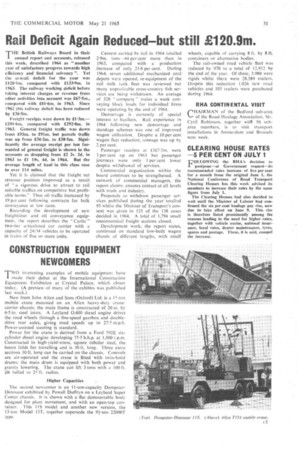Rail Deficit Again Reduced—but still 2120,9m.
Page 33

If you've noticed an error in this article please click here to report it so we can fix it.
'THE British Railways Board in their annual report and accounts, released this week, described 1964 as "another year of satisfactory progress towards high efficiency and financial solvency". Yet the overall deficit for the year was E I 20.9m. compared with £133-9m. in 1963. The railway working deficit before taking interest charges or revenue from ether activities into account was 167.5rn., compared with £81-6m. in 1963. Since 1962 this railway deficit has been reduced by £36.51n.
Freight receipts were down by £1.3m.— £291.6m. compared with £292-8m. in 1963. General freight traffic was down from £93m. to £91m. but parcels traffic was up from £36.2m. to £38.5m. Significantly the average receipt per ton forwarded of general freight is shown in the accounts as dropping from £2 2s. 2d. in 1963 to it 19s. 4d. in 1964. But the average length of haul in this class rose to over 114 miles.
Yet it is claimed that the freight net revenue position improved as a result of "a vigorous drive to attract to rail suitable traffics on competitive but profitable terms." Thus oil traffic increased by 19 per CeRL following contracts for bulk conveyance at low rates.
Recording the development of new freightliner and oil conveyance equipment. the report describes the " Cartie " two-tier articulated car carrier with a capacity of 24/34 vehicles to be operated in trains of five or more units. Cement carried by rail in 1464 totalled 2.9m. tons-44 per cent more than in 1963, compared with a production increase of only 21.6 per cent During 1964. seven additional mechanized coal depots were opened, re-equipment of the rail milk tank fleet was reviewed but many unprofitable cross-country fish services are being withdrawn. An average of 328 company" trains a week conveying block loads for individual firms were operating by the end of 1964.
Demurrage is currently of special interest to hauliers. Rail experience in 1964 following new demurrage and standage schemes was one of improved wagon utilization. Despite a 10 per cent wagon fleet reduction, tonnage was up by 2 per cent.
Passenger receipts at £167-2m. were 3 per cent up on 1963 but passenger journeys were only 1 per cent lower despite withdrawal of services.
Commercial organization within the board cOntinues to be Strengthened. A network of commercial managers, the report claims, ensures contact at all levels with trade and industry.
Proposals to withdraw passenger services published during the year totalled 95 whilst the Minister of Transport's consent was given in 123 of the 138 eases decided in 1964. A total of 1,794 small uneconomical freight stations closed.
Development work, the report states, continued on standard low-built wagon chassis of different lengths, with small
wheels, capable of carrying 8 ft. by 8 ft. containers or alternative bodies.
The rail-owned road vehicle fleet was reduced by 970 to a total of 12.912 by the end of the year. Of these, 3.980 were rigids whilst there were 28.589 trailers. Despite this reduction 1,026 new toad vehicles and 103 trailers were purchased during 1964.
























































































































